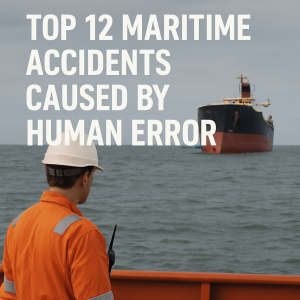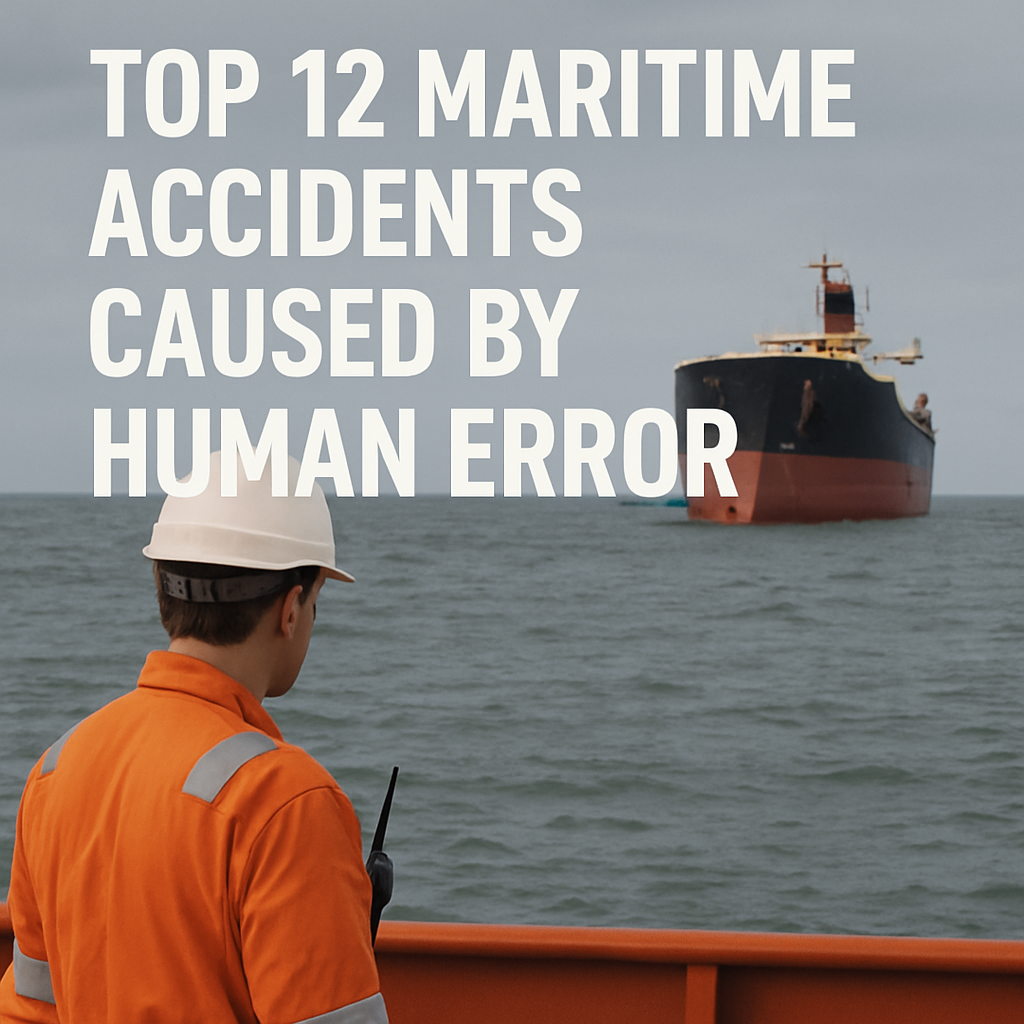Explore 12 major maritime accidents caused by human error in the 21st century. Learn what went wrong, how safety regulations evolved, and what the maritime industry is doing to prevent future tragedies.
Maritime safety has come a long way, yet human error remains one of the leading causes of ship accidents in modern times. From misjudged navigation to overlooked alarms, history continues to show that even with cutting-edge technology, the human factor can never be underestimated. In this article, we explore 12 of the most consequential maritime accidents of the 21st century attributed directly to human error—each serving as a painful yet powerful lesson in operational safety.

Why Human Error Still Matters in the Age of Automation
Despite advancements in navigation, automation, and real-time monitoring, human beings are still at the helm—literally and figuratively. According to the International Maritime Organization (IMO), human error contributes to over 75% of maritime accidents. While technology has improved dramatically, factors like fatigue, communication breakdowns, and lack of training continue to cause major disruptions.
In an industry where small missteps can escalate into international disasters, addressing the root causes of human error is crucial.
1. Costa Concordia (2012) – Navigational Arrogance
When the Costa Concordia cruise ship struck rocks off Giglio Island, Italy, it was not because of a technical failure. Captain Francesco Schettino took an unauthorized detour for a “sail-by salute.” The result? 32 deaths, a capsized vessel, and a $2 billion salvage operation.
Lessons Learned:
- Importance of bridge team management (BTM).
- Strict adherence to voyage plans.
- Better training in emergency evacuation procedures.
Read more from the IMO’s safety updates
2. MV Sewol (2014) – Poor Cargo Loading and Incompetent Response
The South Korean ferry MV Sewol capsized with 476 people on board, including hundreds of students. The overloaded cargo and sharp turn contributed to the disaster, but what truly shocked the world was the crew’s passive response.
Lessons Learned:
- Need for strict regulatory oversight on cargo securing.
- Emergency drills must be practical, not just procedural.
- Passengers must receive clear safety instructions.
3. El Faro (2015) – Sailing into the Eye of a Storm
Sunk during Hurricane Joaquin, El Faro’s demise was traced back to the captain’s decision to sail into dangerous weather. The NTSB report cited fatigue, poor situational awareness, and outdated weather charts.
Lessons Learned:
- Importance of dynamic weather routing.
- Mental health and fatigue management of crew.
- Empowering second officers to challenge the master’s decisions.
4. Prestige (2002) – Misjudged Response to Structural Failure
The oil tanker Prestige developed a hull crack and was denied refuge by Spanish, Portuguese, and French ports. The delay caused it to break apart, spilling over 60,000 tons of oil.
Lessons Learned:
- Human indecision in port authority responses can be catastrophic.
- Emphasized need for places of refuge for distressed vessels (IMO Resolution A.949(23)).
5. MV Wakashio (2020) – Distraction and Negligence
The Japanese bulk carrier ran aground in Mauritius, causing one of the worst ecological disasters in the Indian Ocean. Investigations revealed the ship’s crew had altered course to get closer to shore for Wi-Fi signal.
Lessons Learned:
- Voyage planning protocols must be strictly enforced.
- Over-familiarity with routes leads to carelessness.
See Mauritius Port Authority response
6. Bow Mariner (2004) – Unsafe Tank Cleaning Operations
This chemical tanker exploded off the coast of Virginia, killing 21 seafarers. Crew members were cleaning tanks with flammable benzene, violating safety protocols.
Lessons Learned:
- Mismanagement of hazardous cargoes.
- Importance of using inert gas systems.
- STCW Code compliance for chemical tanker operations.
7. MV Rena (2011) – Navigational Shortcut Gone Wrong
This container ship hit a reef off the coast of New Zealand due to a reckless shortcut. The resulting oil spill and container loss impacted marine life and shipping routes.
Lessons Learned:
- GPS and ECDIS don’t substitute for human vigilance.
- Route planning must prioritize safety over schedule.
8. Britannia Seaways (2013) – Fire from Maintenance Oversight
A cargo fire onboard was traced back to improperly secured equipment and lack of fire-watch during welding.
Lessons Learned:
- Proper work permits and isolation procedures must be followed.
- DNV and Lloyd’s guidelines stress “hot work” safety requirements.
9. MSC Napoli (2007) – Navigational and Communication Failures
Cracks in the hull appeared in heavy weather off the UK coast. Poor communication between the bridge team and poor structural decision-making worsened the incident.
Lessons Learned:
- Importance of early distress communication.
- Structural fatigue assessments must be ongoing.
10. MOL Comfort (2013) – Structural Failure and Poor Oversight
The container ship broke in two in the Indian Ocean, later sinking both sections. While structural integrity was cited, classification society analysis suggested that stress calculations weren’t updated for larger container loads.
Lessons Learned:
- Human error lies in regulatory complacency.
- Continuous reassessment of hull loading parameters is necessary.
11. Exxon Valdez (Technically 1989, Lessons Still Valid Today)
Although pre-21st century, the Exxon Valdez oil spill remains a textbook example of fatigue and alcohol abuse affecting a ship master’s judgment.
Lessons Revisited:
- Crew fitness for duty regulations (ILO MLC 2006).
- Alcohol testing policies are now global standards.
12. Ever Given (2021) – Misjudgment in Constrained Waters
This ultra-large container vessel became famously stuck in the Suez Canal, causing a 6-day blockage of global trade. Though blamed partly on wind, pilot error and excessive speed were also factors.
Lessons Learned:
- Over-reliance on pilotage without bridge team vigilance.
- Real-time traffic management systems must integrate shipmaster feedback.
Read analysis from Lloyd’s List
What Causes These Human Errors?
Experts from the Royal Institution of Naval Architects and the Nautical Institute point to several common human factors:
- Fatigue due to long hours and insufficient rest.
- Poorly designed bridge layouts or equipment interfaces (Human Factors Engineering).
- Inadequate training, especially in emergency protocols.
- Cultural barriers leading to communication breakdowns.
The IMO’s STCW Convention and Code aim to standardize global training, but implementation remains inconsistent.
Global Safety Responses and Preventive Measures
In response to recurring human-error-driven accidents, many authorities and organizations have stepped up:
- IMO’s e-Navigation initiative is improving user-friendly ship interface systems.
- BIMCO and INTERTANKO push for better fatigue risk management.
- Paris MoU inspections now include bridge management assessments.
- Inmarsat and other satellite providers enable real-time weather and traffic warnings.
FAQ: Human Error in Maritime Accidents
1. What percentage of maritime accidents are due to human error?
According to the IMO and EMSA, approximately 75–96% of accidents involve some form of human error.
2. Is automation reducing human error at sea?
Partially. While automated systems help, they also introduce new types of risks such as complacency and over-reliance.
3. Can better training eliminate human error?
Training significantly helps, but human error can never be completely eliminated due to fatigue, stress, and human limitations.
4. What is the STCW Convention’s role in reducing human error?
The Standards of Training, Certification and Watchkeeping (STCW) Convention ensures seafarers meet global training benchmarks.
5. What is a bridge team management (BTM) failure?
It refers to poor coordination, communication, or hierarchy awareness on the ship’s bridge, often leading to accidents.
Conclusion: Maritime Safety Starts with Human Responsibility
Technology can fail, but it is often the human mind that fails first. These 12 incidents highlight the need for vigilance, accountability, and a deeply ingrained safety culture. The sea does not forgive mistakes, and as the industry evolves, so must our systems to prevent and mitigate human error.
Whether you’re a cadet, officer, engineer, or policymaker—these stories are not just history. They are cautionary tales that must inform the future.
References
- International Maritime Organization – Human Element
- EMSA – Annual Overview of Marine Casualties
- Lloyd’s List Intelligence
- IMO STCW Convention
- The Nautical Institute – Bridge Resource Management
- BIMCO – Maritime Safety Reports
- DNV – Maritime Safety Insights
- UNCTAD Review of Maritime Transport
- Paris MoU Annual Report
- Inmarsat Maritime

